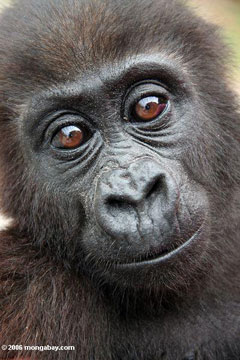Important Congo basin parks get funding
Important Congo basin parks get funding
Wildlife Conservation Society
March 28, 2007
A network of national parks and protected areas spanning three nations in Central Africa’s Congo Basin, has received long-term funding through the establishment of a trust fund, thus ensuring further protection of the region’s wildlife, according to the Wildlife Conservation Society.
Called the Transboundary Sangha Trinational Forest Landscape, the region covers 28,000 square kilometers (10,800 square miles) and includes three contiguous national parks: Lobeke in Cameroon, Dzanga-Ndoki in Central Africa Republic, and Nouabalé-Ndoki in the Republic of Congo. It also contains the highest densities of gorillas, forest elephants and other wildlife in Central Africa.
The trust fund will provide stable, long-term funding for the management of the region’s protected areas. More than 11 million Euros (14.6 million dollars) have already been pledged by the German Bank for Reconstruction (KfW), the French Development Agency (AFD), and WWF/ the German Rainforest Foundation. The fund’s target is 30 million Euros (approximately 40 million dollars). Its legal base is in the United Kingdom but executive offices will be in Cameroon. The fund will be managed by a board of directors including representatives of the Governments of Cameroon, Congo, Central African Republic, Wildlife Conservation Society, World Wildlife Fund and others.

Young gorilla in the Congo basin. Photo by Rhett A. Butler |
“This trust fund will provide a stable source of funding in a globally important region that, for too long, has received too little investment for safeguarding its wildlife,” said James Deutsch, WCS director for Africa Programs. “We are also optimistic that the trust fund will serve as a model for other nations, as well as the donor community to follow.”
This initiative is the result of work done over the past 20 years in partnership among the three concerned governments along with numerous technical and financial partners including AFD, a range of German development aid agencies (BMZ/KFW/GTZ), Wildlife Conservation Society, World Wildlife Fund, the USAID-funded CARPE program, the French Cooperation, the Saccharuna Foundation and the WWF/World Bank Alliance for the conservation and sustainable use of forests.
Related articles
Britain invests $100M to protect Congo rainforest. Britain will invest nearly $100 million (£50m) in a initiative to protect the Congo rainforest, the second largest tropical forest in the world. Ten other countries are also supporting the project.
Congo’s forests get some relief from World Bank grant. Last week the Democratic Republic of Congo (DRC) received a $90-million grant from the World Bank to support the central African country’s transition from instability and civil war. The grant addresses key areas in DRC’s forestry sector and alleviates some of the concerns expressed by environmentalists shortly before the resolution was passed.
The Congo rain forest, an overview of a threatened ecosystem. Known as the heart of darkness by Joseph Conrad, the Congo region has long conjured up thoughts of pygmies, mythical beasts, dreadful plagues, and cannibals. It is a land made famous by the adventures of Stanley and Livingstone and known as a place of brutality and violence for its past — the days of the Arab slave and ivory trade, its long history of tribal warfare — and its present — the ethnic violence and massacres of today.
This is a modified news release from Wildlife Conservation Society